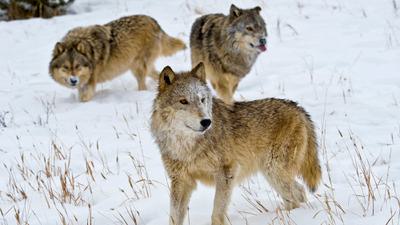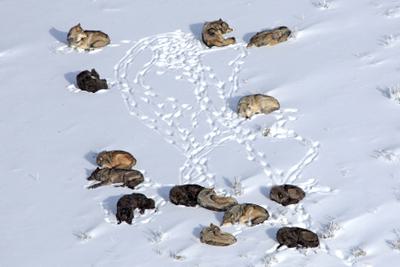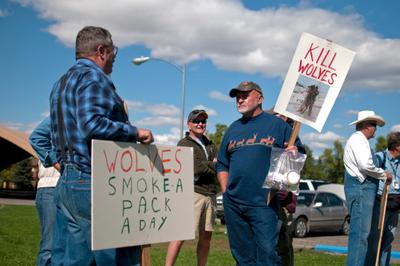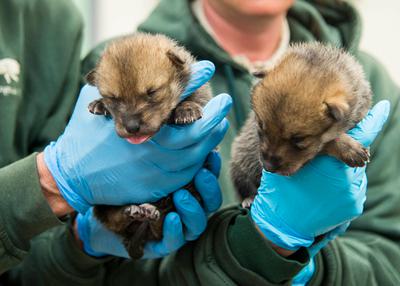In a great wildlife success story, gray wolves were reintroduced and occupied lost habitat across the Northern Rockies.
After 2020, when the Trump administration delisted wolves everywhere save the Northern Rockies and Alaska (where they weren’t listed anyway), Wisconsin authorized killing during the breeding season. During three days in February 2021, 218 wolves were slaughtered.
After virtually extirpating wolves from the West, America briefly recognized them as critical to healthy ecosystems. In 1995 and 1996, 66 wolves were trapped in Canada for release in Yellowstone National Park and central Idaho.
In arguably the greatest success story in the history of wildlife management, gray wolves reoccupied lost habitat across the Northern Rockies. The recovery goal — 15 breeding pairs each in Idaho, Wyoming, and Montana (or about 450 wolves) — was surpassed before decade’s end. By 2020 there were an estimated 1,900 — mostly in Montana, Idaho, and Wyoming, but a few in Oregon, Washington, California, and Colorado. In Michigan, Wisconsin, and Minnesota there were an estimated 4,200.
None of what’s happening now is new or surprising. In 1905 the federal government tried biological warfare, infecting wolves with mange. Ten years later Congress passed a law requiring their eradication from federal land. By 1926 all wolves had been poisoned, shot, and trapped out of Yellowstone National Park. And by 1945 wolves had been essentially eliminated from the American West — all because of the fantasy that they were a major menace to livestock and a threat to big game.
The states fought wolf reintroduction from the get-go. For example, the Eastern Timber Wolf Recovery Plan, released “for discussion only” in 1975, contained naught but suggestions for state-sponsored research. Yet the ink was barely dry when state fish and game bureaucrats decried it as federal meddling. Eastern timber wolf recovery never happened.
This from Vic Van Ballenberghe, retired U.S. Forest Service biologist, former member of Alaska’s Board of Game and still the strongest voice opposing the state’s ineffective, politically motivated war on wolves: “It doesn’t matter if hunters live in Wyoming, Montana, Idaho, Wisconsin, or Alaska, they have the same theories about wolf predation on big-game animals and the same politically powerful organizations that lobby for broadscale wolf reduction.”
Wolves in Idaho and Montana and parts of Washington, Oregon, and Utah had been delisted from the ESA in 2011 via a congressional rider on a must-pass budget bill. So the states assumed management. Trained wildlife professionals in Idaho and Montana set hunting and trapping regulations. In the face of soaring mortality, wolf populations continued to thrive and even expand. Then, in 2021, newly elected conservative legislators took over wolf management.
“It’s about making ‘snowflakes’ cry,” remarks Ed Bangs who led wolf recovery for the Northern Rockies. “Wild-ass hysteria is driving public policy. Invent a nonissue like too many wolves. Fish and game departments had been doing a good job since delisting. Then the legislatures politicized everything and made wolves a symbol of liberals and outsiders. It’s 1850s stuff — let’s show how much we hate wolves and the people who like them, and let’s stick it to the feds.”
A large element of the hunting community hates wolves, too. In fact, with some notable exceptions, hunters are the main driving force in the new war on wolves. The allegation, echoed by politicians, is that overpopulated wolves are devastating deer and elk.
“This isn’t about elk, deer, livestock, or science,” says a critic of wolf hunting. “It’s just old-fashioned persecution, hatred, and cruelty.”
Yet in Wisconsin, grossly overpopulated white-tailed deer are destroying wildlife habitat, including their own. And Dan Ashe, director of the U.S. Fish and Wildlife Service (USFWS) under Obama, offers this: “Elk numbers across the West are way above management objectives. I used to be proud of being a hunter. Not so proud now. Hunting has become radicalized and imbedded with the gun culture and wolf persecution.”
Hunters can’t have it both ways; they can’t brag about performing the ecological function of natural predators and simultaneously demand that those predators be eliminated. Hunters are seeing fewer elk and deer not because wolves have reduced populations, but because wolves have made their prey skittish again. Shooting from truck windows doesn’t work anymore.
Livestock depredation is another make-believe issue. In 2015, 1,904 wolves shared the Rocky Mountain West with 1.6 million cattle. Wolves killed 148 cows, or 0.01 percent, and the states compensated ranchers.
“This isn’t about elk, deer, livestock, or science,” says Ashe. “It’s just old-fashioned persecution, hatred, and cruelty.”
At this writing the only action taken by the Biden administration (other than defending the Trump delisting) has been a year-long wolf status review, as if proof is required that wiping out most of the population is bad for a recovering species.
The Obama administration didn’t put up with this kind of behavior. For instance, when Alaska announced it would shoot wolves from helicopters on 910,000 acres of USFWS-managed wilderness on Unimak Island, Ashe told them no. Alaska said it would proceed anyway. Ashe said, “Okay, my next call is to the Justice Department.” Alaska backed down.
In 2020 the Trump administration reversed an Obama-administration rule that banned killing of wolves and bears and their nursing young on national preserves in Alaska. The Biden administration seems fine with that.
In an op-ed last week, Interior Secretary Deb Haaland expressed support for wolves and alarm at current mismanagement. But she could instantly end the slaughter in the Rockies with an emergency ESA listing.
The administration has another option. Most wolves are killed on land owned by all Americans and managed by the U.S. Forest Service and Bureau of Land Management. These agencies could ban hunter access by snowmobile and ATV, and the wolf slaughter would practically cease.
“Hunters aren’t going to walk into federal land to shoot a wolf,” says Ashe.
At the very least, the Forest Service and BLM could impose fair-chase regulations such as banning running over wolves, night-hunting, and killing pups and nursing mothers in dens. Thus far, silence.
So frightened of political fallout is the National Park Service that it has gagged Yellowstone biologists. Still, the park’s superintendent, Cam Sholly, entreated Montana’s new Republican Governor Greg Gianforte to restore the wolf-protection buffer around the park. Since becoming governor last year, Gianforte has been cited for illegally trapping and shooting a wolf near the former buffer zone without completing the required trapping-education program. Sholly got nowhere with him.
People come to Yellowstone to see wolves and spend money on hotels and restaurants. A dead wolf might fetch a hunter $200.
Yellowstone had been an oasis for wolves. No longer. Having encountered only tourists firing cameras, park wolves don’t fear humans. Now when they leave the park, hunters shoot them as easily as if they were pet dogs. Yellowstone used to lose two or three wolves a year to hunters and trappers. So far this winter it has lost 24, including breeding females. Such mortality is unsustainable.
People come to Yellowstone to see wolves, then spend money on hotels, shops, and restaurants. Park officials estimate that each of Yellowstone’s 90 remaining wolves is worth around $1 million. A dead one might fetch a hunter or trapper a one-time profit of $200, provided the pelt was prime. And wolves have greatly increased Yellowstone’s biodiversity because overpopulated elk had ravaged woody vegetation.
“What do you think 3 million tourists who come to Yellowstone each year are hearing about why they couldn’t see a wolf or why is this wolf limping,” says Bangs. “Who needs that bad press?”
All wolf news isn’t bad. On February 10, 2022 a federal judge restored endangered-species status to wolves in contiguous states outside the Northern Rockies.
While wildlife professionals in Idaho and Montana remain largely silent, Wisconsin’s have been condemning the political takeover of their jobs. Then, when tribes and wildlife groups sued and stopped the planned November hunt, the state didn’t appeal. Wisconsin’s is a prouder story.
Colorado Parks and Wildlife, which has traditionally resisted wolf reintroduction, no longer has a choice. State voters required reintroduction with a November 3, 2020 ballot initiative. The agency must have a plan in place by December 31, 2023.
After a rocky start, endangered Mexican wolves are finally prospering in the Southwest. The 186 in the wild primarily issue from seven animals. So inbreeding was a concern. Now that’s dealt with via “cross fostering,” a process by which captive pups bred in zoos are swapped with pups from wild litters and the wild pups raised at the zoos. Some wild pups are left in each litter. Mexican wolves are now expanding into Colorado from Arizona and New Mexico.
And wolves from the Rockies are moving into northern Colorado. Will the mixing of delisted and endangered subspecies cause a problem? For humans maybe, not for the wolves. “You want a metapopulation — what it used to be from Arctic to subtropics,” says Ashe. “At some point we’ll have that again.”
Finally, wolf persecution is immensely unpopular with the public. Among the many outraged letters sent to the Biden administration have been seven from: 85 members of the U.S. House of Representatives; 21 U.S. senators; 634 Canadian first nations; nearly 200 U.S. tribal leaders; 30 business leaders; 61 conservation groups; and 800-plus scientists.
Maybe the scientists say it best: “Such practices contradict 21st century conservation management that stresses the benefit of returning natural predators to the landscape, which in turn restores functioning ecosystems … The U.S. Department of Interior invested millions of taxpayer dollars to restore wolf populations that had dwindled to the point of local extinction in the Northern Rockies. This reintroduction and subsequent recovery were heralded as a conservation triumph and won the U.S. government international acclaim for preventing a species from going extinct.”






